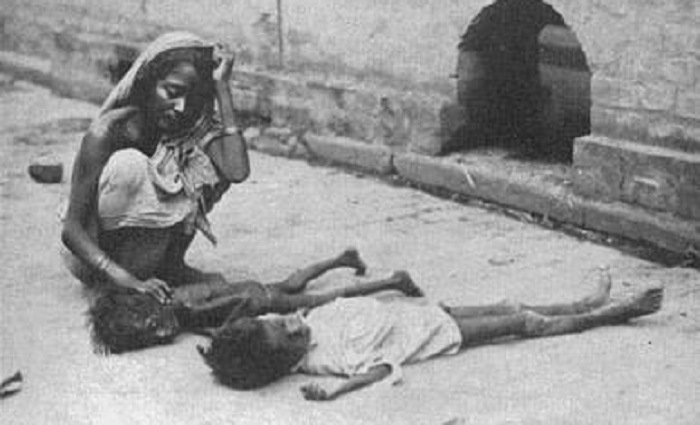The Bengal famine of 1943 was one of the most devastating famines in history that hit the Bengal province in British India at the time of the Second World War. It was a major famine that claimed lives of around 2.1–3 million people. The deaths were predominantly caused due to starvation and diseases like malaria and cholera that got worsened because of population displacement, malnutrition, poor sanitation and paucity of health care. Historians often tag the famine as “man-made” pressing that it was created and intensified by wartime colonial policies.
(Source: https://en.wikipedia.org/wiki/Bengal_famine_of_1943)
 Image Source: https://en.wikipedia.org/wiki/Famine
Image Source: https://en.wikipedia.org/wiki/Famine
Real Causes of the Bengal famine of 1943
The main reason for the famine of 1943 in Bengal, considered a land of rice growers and rice eaters, was apparently shortage of rice. Although Bengal mainly had an agrarian economy and produced one third of India’s rice, around half to three-quarters of the poor in rural areas were facing a semi-starved condition in the years prior to the famine. According to many it was not only supply shortage but also improper allocation of available rice stocks and several other natural, social, economic and politics factors and events that aggravated the situation resulting in such catastrophic famine.
Rapid increase in population compared to fixed land base and agricultural productivity including decades of declining rice production was posing a continuous threat of inadequacy. This was leading to a long-term fall in per capita availability of rice and increase in count of landless labourers. Many were also struck by the increasing debt-cycle, some of which were marked with usurious rates of interest, which resulted in bonded labour and loss of land because of land-grabbing. During the Great Depression, several formal credit market entities disappeared making way for informal credit market, manipulation of which led to land-grabbing. Peasants having small landholdings had to lent money from informal local lenders for different purposes including sustaining during lean months between harvests and purchasing different means of farming. Eventually many fell into the spiralling debt-cycle, more so with poor harvest, and unable to pay debt, they had to forfeit their lands to their creditors. This was witnessed in several districts of Bengal among the lowest tier of economic classes. During the famine, noticeably the landless agricultural labourers suffered the most in terms of impoverishment and death.
1942 relatively had a poor harvest in winter crop leading to shortages in supply. After the Empire of Japan occupied Burma (present-day Myanmar) same year, rice imports from Burma were lost. This was followed by British “denial policies” for rice and boats which in turn adversely affected much of market supplies and transport systems of Bengal. Fearing invasion of Japanese forces in British India through Burma via the eastern border of Bengal, the British military authorities set in motion a two-pronged scorched-earth initiative in eastern and coastal Bengal. These measures denied access to transport, food supplies and other resources. In late-March 1942, the then governor of Bengal, John Herbert, issued directive to destroy all boats and rice stocks in coastal Bengal which took Bengal a step forward to the devastating famine. In addition to these, Southwestern Bengal witnessed large-scale natural disasters including a cyclone that struck on January 9, 1943 resulting in flooding the rice fields with salt water. It claimed thousands of lives and witnessed an outbreak of the Helminthosporium oryzae fungus that badly affected the remaining rice plants
 Image Source: https://en.wikipedia.org/wiki/Bengal_famine_of_1943
Image Source: https://en.wikipedia.org/wiki/Bengal_famine_of_1943
Important supplies were prioritised and distributed by the British government to the military, civil servants and other classes considered important. Moreover emergency inter-provincial trade barriers on rice and other food grains were implemented further aggravating the situation. Although restrictions were temporarily lifted for eastern states, however these were later resumed as price of rice started increasing in other states. Attempts were made to influence price of rice paddy applying price controls. However fixed low price made the sellers reluctant in selling rice which led to disappearance of stocks either into the black market or into storage. Speculation and hoarding led to hyperinflation. Again, on the context of wartime shortage of shipping, Churchill’s War Cabinet denied access to international sources. Australian Wheat shipments passed along the Indian coast however these were not diverted to reduce the plight of millions starving in Bengal. Policies of the provincial government started to fail after it was denied that a famine existed. The government in fact never made any formal declaration of a state of famine in Bengal. Nevertheless as news of Bengal’s troubled situation reached the west, the British government was offered food aid, particularly for Bengal, by the United States and Canada, which was also turned down by London.
One of the contributing factors of excessive mortality during the famine was development of railways in Bengal during late 19th century and early 20th century. Natural drainage of Bengal was disturbed due to construction of a network of railway embankments resulting in formation of poorly drained “compartments” in different areas of Bengal. This led to excessive silting, damaged crop production, increased chance of flooding and created stagnant water pockets that were apt for water-borne diseases like cholera and malaria. The railways tracks became ideal places for such diseases. Flooding of fallow fields, slower drainage, partially drained tanks in dry seasons and other factors also created breeding place for malaria-carrying mosquitoes.
Another cause was the consequences of the Second World War that saw war-time inflation triggered by military build-up and financing. Thousands of Bengalis lost their lands due to seizure. Such social, economic and political forces adversely affected income distribution structure of Bengal including its agricultural sector in sustaining its populace. The social and economic groups were bogged down by poverty and indebtedness and strived in tackling the economic shocks and distress they experienced in 1942 and 1943 amidst the Second World War.
(Source:https://en.wikipedia.org/wiki/Bengal_famine_of_1943, https://www.thoughtco.com/the-bengal-famine-of-1943-195073, https://medium.com/@Prakhar__Singh/real-causes-of-the-devastating-bengal-famine-1943-daac8389495e)
 Image Credit : https://te.wikipedia.org/wiki/%E0%B0%A6%E0%B0%B8%E0%B1%8D%E0%B0%A4%E0%B1%8D%E0%B0%B0%E0%B0%82:Bengal_famine_1943.png
Image Credit : https://te.wikipedia.org/wiki/%E0%B0%A6%E0%B0%B8%E0%B1%8D%E0%B0%A4%E0%B1%8D%E0%B0%B0%E0%B0%82:Bengal_famine_1943.png
Famine, disease, and the death toll – How many people died in Bengal famine 1943?
Bengal witnessed different rates of famine in different districts. According to the Government of India, the first Japanese air raids on Calcutta, starting from December 20, 1942, initiated the Bengal food crisis. Thousands shifted from the city to countryside during such raids while the city food-grain dealers closed their shops. The authorities seized rice stocks from wholesale dealers to feed workers in prioritised industries in Calcutta. The food crisis thus began. By May 1943 there was full-scale famine. Reports of a “sudden and alarming” inflation, with rice price almost doubling, started coming from different commissioners and district officers after December 1942 and that of sufferings from serious food supply issues started coming in January 1943. Death by starvation was first reported by six districts in May 1943. These were Tipperah, Bakarganj, Mymensingh, Rangpur, Chittagong and Noakhali, among which the latter two both “boat denial” districts in the Ganges Delta region, were hit the most. Although situation in some Bengal districts were comparatively less severe and deaths from starvation was mostly seen among rural poor, no area in Bengal was totally immune to increase in death toll due to diseases. Starvation and disease again complimented and intensified each other escalating the mortality rate. Suffering from weak immune systems due to starvation and malnutrition paved way for reduced resistance to disease resulting in death due to infections. Situation became worse with population displacement that led to overcrowding, poor water quality, unsanitary conditions, poor waste disposal, rise in vermin and unburied dead. This again led to the incidental spreading of infectious diseases.
 Image credit : https://en.wikipedia.org/wiki/Bengal_famine_of_1943
Image credit : https://en.wikipedia.org/wiki/Bengal_famine_of_1943
Mortality statistics provided were to some extent under-recorded, especially for the countryside. Starvation seemed to be the main cause of excess mortality from May to October 1943. It peaked by November 1943 and was then taken over by disease-related deaths by December 1943 continuing through early-to-mid 1944. Malaria proved to be most fatal disease during the famine with monthly death toll from malaria averaging 125% above rates from the previous five years, during July 1943 to June 1944, while reaching 203% over average in December 1943. Other famine-related diseases that furthered the death count include dysentery and diarrhoea, deaths from both of which peaked in December 1943; and waterborne disease cholera and airborne disease smallpox, deaths from which peaked in October 1943 and April 1944 respectively. The latter two diseases were associated with crowded living arrangements as in refugee camps. According to reports roughly 43% of the excess deaths in 1943 and 71% in 1944 were due to malaria while cholera amounted to 24% deaths in 1943 and 1% in 1944 and smallpox amounted to 1% of excess deaths in 1943 but reached 24% the next year. At that time, starvation was generally not listed as a cause of death and possibly its count was included under the “All other” category. The high death rate from “All other” causes in 1943 was obviously mostly due to starvation. The rate became negligible the following year.
(Source: https://en.wikipedia.org/wiki/Bengal_famine_of_1943)
Effects (Social, Economic & Political)
The social structure of Bengal was severely disrupted by the famine. While medical facilities in Bengal pathetically strived in coping with increasing health care issues, there was huge delay in key supplies like food relief and medical rehabilitation. Large landowners in rural areas, who otherwise acted patrons of rural poor during crisis times, exhausted their own resources and thus were unable to help the peasants. The survival struggle started off with reduction of food intake and then families started selling jewelry, ornaments, and other smaller items before selling or mortgaging their immovable properties. Matters worsened that witnessed disintegration and abandonment of families, prostitution, sexual exploitation and child selling. Many children became homeless and orphans. Small children were seen begging. One schoolteacher in Mahisadal saw children picking and eating undigested grains from diarrheal discharge of a beggar. Mass displacement led to decline of sanitary conditions and hygiene standards while disposal of corpses in rivers and water supplies contaminated drinking water giving rise to diseases. Dead bodies were also left to rot and putrefy in open spaces which attracted vultures and jackals. The crisis also led to cloth famine and instances of robbing clothes from graveyards, disrobing people for dearth of clothes and minor sporadic rioting were also reported.
 Image Credit: https://en.wikipedia.org/wiki/Bengal_famine_of_1943
Image Credit: https://en.wikipedia.org/wiki/Bengal_famine_of_1943
The famine overpowered and impoverished large segments of economy of Bengal severely disturbing important economic elements of the province, ruining millions of families and leading to poverty and income inequality. The latter was palpable from the compulsive strategy of selling assets for food. According to sources, around 1.6 million families, which accounts to roughly one-fourth of smallholders and dwarf-holders, made effort to survive by selling or mortgaging their paddy lands. This eventually led them to become labourers from landholders. The four years following 1941 recorded increase in land transfers by 504%, 665%, 1,057% and 872%.
The British government’s response to the crisis led to a general discontent and resentment paving way for important political ramifications. Several political groups including the Indian National Congress staged protests condemning the denial policies of the British Raj that proved drastic for Bengali peasants. There were nationwide opposition to the boat denial policy. Such nationalist sentiments that were observed across the country bolstered the Indian independence movement and contributed significantly to the way the ‘Quit India’ movement of 1942 shaped up.
(Source: https://en.wikipedia.org/wiki/Bengal_famine_of_1943)


